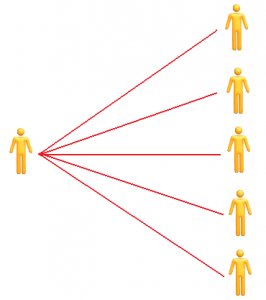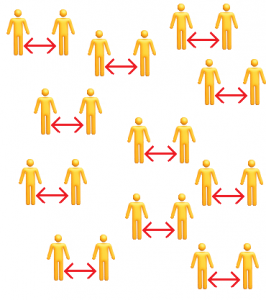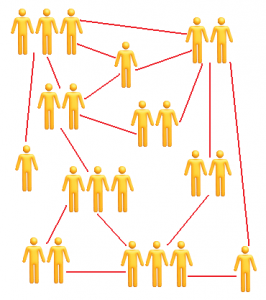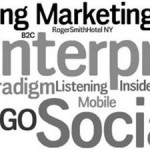2009 had become an era where traditional marketing strategies had almost become absolute. Companies and consumers had stated using social networking as it allows users to reach anyone anytime with a specific and personalized message. From a marketer’s perspective, this is definitely more valuable than one strategy which constraints you by only sending a single message to the entire network.
There are 3 value-governance laws that speak to the fundamental value of a network from the perspective of those connected to it. These laws describe the potential value to any given network on the basis of how participants are connected. The laws that introduce the law of social networks and the communities are shown in order of increasing importance with regard to the use of the social media.
1. Sarnoff’s Law

- It states that the value of a broadcast network is direct proportional to the number of viewers.
- Example: A radio network station broadcast a single message to the millions of listeners.
- Effect: A network with 100 people is only 10 times as valuable in terms of reach as a network with only 10, all other things being roughly equal.
2. Metcalfe’s Law

- It states that the value of any telecommunications network is proportional to the square of the number of connected users of the system. People could talk in both directions and with more than one conversation occurring simultaneously.
- Example: You sent an email to your targeted recipients.
- Effect: A network of 100 people is roughly 100 times as valuable as a network of only 10 people.
3. Reed’s Law

- It is the formation of large networks, particularly social networks, can scale exponentially with the size of an network. This value of network grows more powerfully than either Sarnoff or Metcalfe.
- Example: You post a message in a group, community or social networking platform like twitter.
- Effect: A network of 100 people is many times (basically an exceeding large number)) as valuable as compared with a network of 10 people.
Social network encourage the creation of and communication between subgroups. The talking in groups can result in more efficient filtering, vetting and emphasis of related information. Thus this incredible power of communities is in being “tapped” by fundamental organization and administrative policies of social networks. Social networking is very effective in receiving and sharing information. These strongly interconnected social networks are equally perceived as effective in vetting that information and it is the combined impact that makes social networks along with user-generated content and social media so powerful from a consumer’s perspective. Online community members are discovering that it is very easy to find, learn about and share information that directly contributes to an informed choice. This explains why people are moving towards social media and this could be a reason for you to be there too.










 Developing the product’s brand is perhaps the most challenging for business owners. The competition is always working toward the same goal: create a necessity product that is unique from others. Consumers often search for the cheapest, most effective or most popular product. So if you do not fall into any of these three categories, you […]
Developing the product’s brand is perhaps the most challenging for business owners. The competition is always working toward the same goal: create a necessity product that is unique from others. Consumers often search for the cheapest, most effective or most popular product. So if you do not fall into any of these three categories, you […] In this fast paced modern world, everybody is in search of those advertising channels which can provide fastest outcomes within short interval of time. This is the reason, why people are moving towards social networking on internet which is considered to be one of the most effectual ideas till now. Basically, social networking is meant […]
In this fast paced modern world, everybody is in search of those advertising channels which can provide fastest outcomes within short interval of time. This is the reason, why people are moving towards social networking on internet which is considered to be one of the most effectual ideas till now. Basically, social networking is meant […] The mobile phone is most important whenever an emergency arises and anyone can contact and reach to you. One of the other features is messaging that is you can text your friends and at a time talks to several people. It also helps to give any important message if a person is not available on […]
The mobile phone is most important whenever an emergency arises and anyone can contact and reach to you. One of the other features is messaging that is you can text your friends and at a time talks to several people. It also helps to give any important message if a person is not available on […] It only takes a few minutes to follow someone on Twitter. The “follow-me on Twitter” model is what people use to get people to communicate with them on their Twitter website. This is the way that people get acquaintance with one another as you participate in conversations with them.
It only takes a few minutes to follow someone on Twitter. The “follow-me on Twitter” model is what people use to get people to communicate with them on their Twitter website. This is the way that people get acquaintance with one another as you participate in conversations with them.